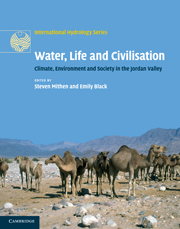Book contents
- Frontmatter
- Contents
- List of figures
- List of tables
- List of contributors
- Acknowledgements
- 1 Introduction: an interdisciplinary approach to Water, Life and Civilisation
- Part I Past, present and future climate
- 2 The present-day climate of the Middle East
- 3 Past climates of the Middle East
- 4 Future climate of the Middle East
- 5 Connecting climate and hydrological models for impacts studies
- Part II The palaeoenvironmental record
- Part III Hydrological studies of the Jordan Valley
- Part IV Human settlement, climate change, hydrology and water management
- Part V Palaeoeconomies and developing archaeological methodologies
- Part VI Society, economy and water today
- Part VII Conclusions
- Index
- Plate section
- References
4 - Future climate of the Middle East
from Part I - Past, present and future climate
Published online by Cambridge University Press: 26 April 2011
- Frontmatter
- Contents
- List of figures
- List of tables
- List of contributors
- Acknowledgements
- 1 Introduction: an interdisciplinary approach to Water, Life and Civilisation
- Part I Past, present and future climate
- 2 The present-day climate of the Middle East
- 3 Past climates of the Middle East
- 4 Future climate of the Middle East
- 5 Connecting climate and hydrological models for impacts studies
- Part II The palaeoenvironmental record
- Part III Hydrological studies of the Jordan Valley
- Part IV Human settlement, climate change, hydrology and water management
- Part V Palaeoeconomies and developing archaeological methodologies
- Part VI Society, economy and water today
- Part VII Conclusions
- Index
- Plate section
- References
Summary
ABSTRACT
A survey of publicly available data from the Intergovernmental Panel on Climate Change (IPCC) suggests that the Middle East will become significantly drier as greenhouse gas levels rise – with potentially devastating consequences. Simulating the climate of the eastern Mediterranean and the Middle East is, however, a tough challenge for climate models and those results should be interpreted with caution. The cyclones which migrate from west to east across the Mediterranean in winter and early spring, and which deliver much of the annual precipitation to the Middle East, are not well resolved by global climate models of the type included in the IPCC archive. Furthermore, the local climate is modified by coastlines and mountains throughout the region. For these reasons we provide a supplement to the IPCC results with simulations from a regional climate model. As in the global models, the regional model projects that, under an A2 (business-as-usual) scenario, precipitation will decrease significantly in the Middle East. Further investigation of the daily statistics of the weather, along with tracking of weather systems in the present day and future climate scenarios, suggest that the dominant mechanism for these changes is a reduction in the strength of the Mediterranean storm track. The Mediterranean storm track is fairly well simulated by the regional climate model, increasing confidence in this projection. […]
- Type
- Chapter
- Information
- Water, Life and CivilisationClimate, Environment and Society in the Jordan Valley, pp. 51 - 62Publisher: Cambridge University PressPrint publication year: 2011
References
- 2
- Cited by

